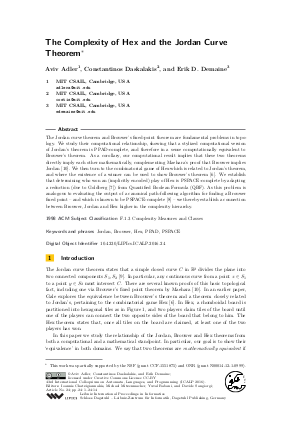The Complexity of Hex and the Jordan Curve Theorem
Authors Aviv Adler, Constantinos Daskalakis, Erik D. Demaine
-
Part of:
Volume:
43rd International Colloquium on Automata, Languages, and Programming (ICALP 2016)
Part of: Series: Leibniz International Proceedings in Informatics (LIPIcs)
Part of: Conference: International Colloquium on Automata, Languages, and Programming (ICALP) - License:
 Creative Commons Attribution 3.0 Unported license
Creative Commons Attribution 3.0 Unported license
- Publication Date: 2016-08-23
File

PDF
LIPIcs.ICALP.2016.24.pdf
- Filesize: 1.15 MB
- 14 pages
Document Identifiers
Subject Classification
Keywords
- Jordan
- Brouwer
- Hex
- PPAD
- PSPACE
Metrics
- Access Statistics
-
Total Accesses (updated on a weekly basis)
0Document
0Metadata
Abstract
The Jordan curve theorem and Brouwer's fixed-point theorem are fundamental problems in topology. We study their computational relationship, showing that a stylized computational version of Jordan’s theorem is PPAD-complete, and therefore in a sense computationally equivalent to Brouwer’s theorem. As a corollary, our computational result implies that these two theorems directly imply each other mathematically, complementing Maehara's proof that Brouwer implies Jordan [Maehara, 1984]. We then turn to the combinatorial game of Hex which is related to Jordan's theorem, and where the existence of a winner can be used to show Brouwer's theorem [Gale,1979]. We establish that determining who won an (implicitly encoded) play of Hex is PSPACE-complete by adapting a reduction (due to Goldberg [Goldberg,2015]) from Quantified Boolean Formula (QBF). As this problem is analogous to evaluating the output of a canonical path-following algorithm for finding a Brouwer fixed point - and which is known to be PSPACE-complete [Goldberg/Papadimitriou/Savani, 2013] - we thereby establish a connection between Brouwer, Jordan and Hex higher in the complexity hierarchy.
Cite As Get BibTex
Aviv Adler, Constantinos Daskalakis, and Erik D. Demaine. The Complexity of Hex and the Jordan Curve Theorem. In 43rd International Colloquium on Automata, Languages, and Programming (ICALP 2016). Leibniz International Proceedings in Informatics (LIPIcs), Volume 55, pp. 24:1-24:14, Schloss Dagstuhl – Leibniz-Zentrum für Informatik (2016)
https://doi.org/10.4230/LIPIcs.ICALP.2016.24
BibTex
@InProceedings{adler_et_al:LIPIcs.ICALP.2016.24,
author = {Adler, Aviv and Daskalakis, Constantinos and Demaine, Erik D.},
title = {{The Complexity of Hex and the Jordan Curve Theorem}},
booktitle = {43rd International Colloquium on Automata, Languages, and Programming (ICALP 2016)},
pages = {24:1--24:14},
series = {Leibniz International Proceedings in Informatics (LIPIcs)},
ISBN = {978-3-95977-013-2},
ISSN = {1868-8969},
year = {2016},
volume = {55},
editor = {Chatzigiannakis, Ioannis and Mitzenmacher, Michael and Rabani, Yuval and Sangiorgi, Davide},
publisher = {Schloss Dagstuhl -- Leibniz-Zentrum f{\"u}r Informatik},
address = {Dagstuhl, Germany},
URL = {https://drops.dagstuhl.de/entities/document/10.4230/LIPIcs.ICALP.2016.24},
URN = {urn:nbn:de:0030-drops-63032},
doi = {10.4230/LIPIcs.ICALP.2016.24},
annote = {Keywords: Jordan, Brouwer, Hex, PPAD, PSPACE}
}
Author Details
References
-
Aviv Adler, Constantinos Daskalakis, and Erik Demaine. The Complexity of Hex and the Jordan Curve Theorem. Arxiv, 2016.

-
Xi Chen and Xiaotie Deng. On the Complexity of 2D Discrete Fixed Point Problem. In the 33rd International Colloquium on Automata, Languages and Programming (ICALP), 2006.

-
Constantinos Daskalakis, Paul W. Goldberg, and Christos H. Papadimitriou. The Complexity of Computing a Nash Equilibrium. In the 38th Annual ACM Symposium on Theory of Computing (STOC), 2006.

-
Constantinos Daskalakis and Christos H. Papadimitriou. Continuous local search. In the Twenty-Second Annual ACM-SIAM Symposium on Discrete Algorithms (SODA), 2011.

-
Kousha Etessami and Mihalis Yannakakis. On the Complexity of Nash Equilibria and Other Fixed Points (Extended Abstract). In the 48th Annual IEEE Symposium on Foundations of Computer Science (FOCS), 2007.

-
David Gale. The game of Hex and the Brouwer fixed-point theorem. American Mathematical Monthly, pages 818-827, 1979.

-
Paul Goldberg. The Complexity of the Path-following Solutions of Two-dimensional Sperner/Brouwer Functions. arXiv, 2015.

-
Paul W Goldberg, Christos H Papadimitriou, and Rahul Savani. The Complexity of the Homotopy Method, Equilibrium Selection, and Lemke-Howson Solutions. ACM Transactions on Economics and Computation, 1(2):9, 2013.

-
Camille Jordan. Cours d'analyse de l'École polytechnique, volume 1. Gauthier-Villars et fils, 1893.

-
Ryuji Maehara. The Jordan curve theorem via the Brouwer fixed point theorem. American Mathematical Monthly, pages 641-643, 1984.

-
Christos H. Papadimitriou. On the Complexity of the Parity Argument and Other Inefficient Proofs of Existence. Journal of Computer and System Sciences, 48(3):498-532, 1994.

